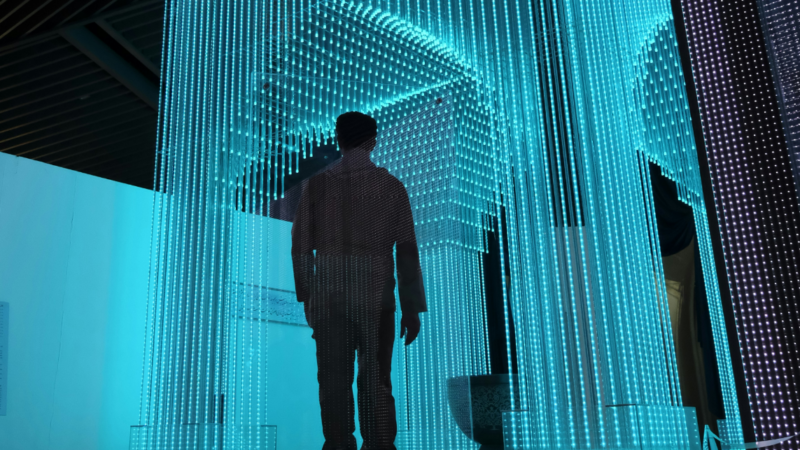Making sense of our connected world

Between time savings and additional effort: Generative AI in the workplace
AI-based chatbots are transforming the workplace significantly. They are assisting in information retrieval, analysis and text creation, promising substantial productivity gains. Consequently, generative AI is often portrayed in the media as a catalyst for employee productivity. In practice, however, employees report contradictory experiences. While ChatGPT saves time on research, for example, it also creates additional work in fact-checking. This article explores the paradoxical impact of generative AI in the workplace.
AI-based chatbots such as Open AI’s GPT-4 are highly versatile. They can be used for searching, analysing and summarising information, as well as generating and editing ideas, texts and codes. Because of their technological maturity and wide range of uses, these AI applications are attractive to both companies and employees. Yet, opinions diverge on their impact.
Generative AI as a productivity catalyst
A few months after the hype around ChatGPT began, researchers began publishing working papers attesting to the program’s significant potential to boost employee productivity (Brynjolfsson et al., 2023; Noy & Zhang, 2023). These and similar studies have led to a media narrative depicting generative AI as a productivity catalyst that can reduce employee workloads and accelerate processes for employees. Headlines claim that AI boosts worker productivity by 14%, and another article compares the anticipated productivity gains from generative AI to those of the Industrial Revolution. However, what those articles often overlook is that the studies in question are based on experiments that do not necessarily reflect real working conditions and are focused on specific professions (such as customer service).
Generative AI as a catalyst for additional work and bureaucracy
Contrary to the dominant media narrative, critical voices emerged soon after the release of ChatGPT. In an article for The Atlantic, Ian Bogost argued that ChatGPT is burdening us with more work. On top of all our existing tasks, we now need to spend time distinguishing between human and AI-generated content and dealing with the associated bureaucracy. Numerous examples illustrate this point. Universities must decide how to handle AI-generated student papers, academic journals must determine the extent to which AI can be used in submissions and societies must address AI-generated misinformation.
Paradoxes in the context of technologies
In our quest to understand these contradictory perspectives, we can benefit from a paradox perspective. A paradox in the context of technological change refers to inherent contradictions, dilemmas or unexpected consequences arising from the use and development of technology (Mick & Fournier, 1998). A paradox means that technologies can simultaneously produce X and -X, such as fostering independence while leading to dependency, conveying the feeling of intelligence alongside the feeling of ignorance, and bringing people together while also causing isolation. A prime example of this is the smartphone. It makes it easier to stay in touch with friends and family yet makes it more difficult to deeply connect during in-person interactions.
Paradoxes in working with ChatGPT
A recent study involving 48 interviews with advertising industry professionals explored how ChatGPT impacts their work. The findings reveal that employees experience ChatGPT’s impact as contradictory and identify three paradoxes in their interaction with the program (Osadchaya et al., 2024). First, ChatGPT both facilitates and obstructs research. While employees find AI-based chatbots such as ChatGPT more effective than search engines, they also bemoan the extra effort required to verify the answers. Second, AI-based chatbots promote both creativity and standardisation. Though respondents use ChatGPT beneficially in the creative process, they also observe an increasing homogenisation of advertising messages. Third, from the respondents’ perspective, using ChatGPT leads to both efficiency gains and losses. You can quickly generate a blog post such as this one, but then you have to spend a lot of time revising it, both validating facts and adjusting the tone to avoid the text from sounding too AI-generated.
Outlook
My own preliminary analyses of online forum discussions among creatives in the advertising industry align with the study’s findings. This does not imply that generative AI cannot enhance employee productivity. However, the productivity effects may have been overestimated in initial studies. Understanding why this is the case and when the negatives outweigh the positives remains an open question that requires further research. Such research needs to consider the application context more thoroughly. For this very reason, we have decided to investigate the applications and impacts of generative AI in selected professional fields such as human resources and marketing in our project “Generative AI in the Workplace”.
References
Brynjolfsson, E., Li, D., & Raymond, L. R. (2023). Generative AI at Work. https://www.nber.org/papers/w31161
Mick, D. G., & Fournier, S. (1998). Paradoxes of Technology: Consumer Cognizance, Emotions, and Coping Strategies. Journal of Consumer Research, 25(2), 123-143. https://doi.org/10.1086/209531
Noy, S., & Zhang, W. (2023). Experimental Evidence on the Productivity Effects of Generative Artificial Intelligence. Available at SSRN 4375283. https://papers.ssrn.com/sol3/papers.cfm?abstract_id=4375283
Osadchaya, E., Marder, B., Yule, J. A., Yau, A., Lavertu, L., Stylos, N., Oliver, S., Angell, R., Regt, A. d., Gao, L., Qi, K., Zhang, W. Z., Zhang, Y., Li, J., & AlRabiah, S. (2024). To ChatGPT, or not to ChatGPT: Navigating the paradoxes of generative AI in the advertising industry. Business Horizons. https://doi.org/10.1016/j.bushor.2024.05.002
This post represents the view of the author and does not necessarily represent the view of the institute itself. For more information about the topics of these articles and associated research projects, please contact info@hiig.de.

You will receive our latest blog articles once a month in a newsletter.
Digital future of the workplace
AI at the microphone: The voice of the future?
From synthesising voices and generating entire episodes, AI is transforming digital audio. Explore the opportunities and challenges of AI at the microphone.
Do Community Notes have a party preference?
This article explores whether Community Notes effectively combat disinformation or mirror political biases, analysing distribution and rating patterns.
How People Analytics can affect the perception of fairness in the workplace
People Analytics in the workplace can improve decisions but may also heighten feelings of unfairness, impacting employee trust and workplace relationships.




